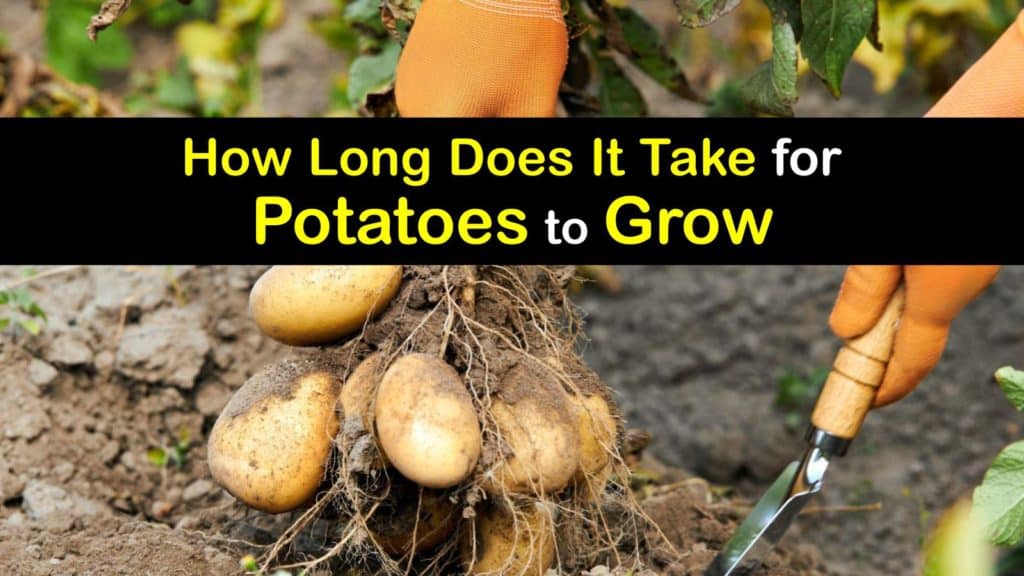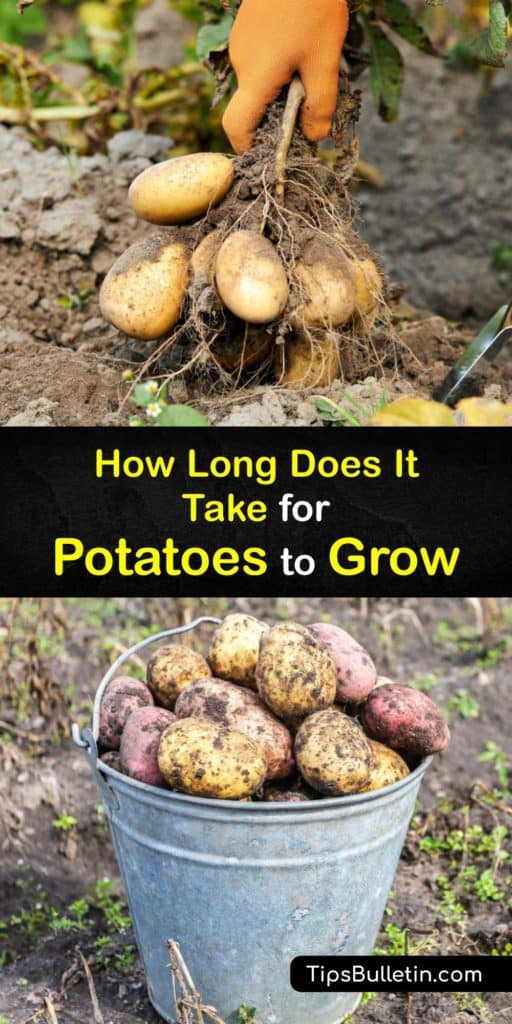Harvesting potatoes at the end of the growing season is like a treasure hunt. However, it’s sometimes challenging to know when they’re ready to harvest since they develop underground. That leaves some gardeners wondering, “How long does it take to grow potatoes?”
The answer is, it depends on which varieties of potatoes you’re growing. In general, potatoes are classified as early, mid, and late-season types based on how long the tubers take to develop.
Other factors that influence the time it takes for potato plants to mature include growing conditions like air and soil temperature, sunshine, and rainfall levels. For ideal results, plant potatoes in a location that gets full sun and has rich, well-draining soil.

How Fast do Potatoes Grow?
Growing potatoes in a raised bed is advantageous because it keeps the soil warmer and minimizes weed growth, both of which help the plants grow faster and stronger. Read on to find out the answer to the question, “How fast do potatoes grow?”
Early-season potatoes are the fastest-growing varieties. They’re usually ready for harvest in 60-80 days. Midseason potatoes typically get harvested after 80-95 days. If you plant a late variety, expect to harvest between 95-130 days after planting potatoes.
New potatoes get harvested before they’re fully mature and have a more tender texture and thinner skin than mature potatoes. They are also called baby potatoes and are about the same size as a chicken egg. Begin harvesting new potatoes about 50 days after planting.
The timing of your potato harvest should be a significant factor in determining which types of potatoes to grow. Potatoes tend to grow best between 60-70 degrees Fahrenheit.
When temperatures exceed 80 degrees Fahrenheit, mature potatoes may become discolored or woody. To harvest before hot weather sets in, plant seed potatoes around the last frost date in early spring, as soon as you can work the soil.
Homegrown veggies are always tastier and more nutritious than produce from the grocery store, and potatoes are no exception.

They’re rich in antioxidants, fiber, potassium, and magnesium. These nutrients help to improve digestive health, lower blood pressure and cholesterol, regulate blood sugar levels, and reduce the risk of chronic diseases.
About How Long does It Take for Potatoes to Sprout?
Have you ever wondered, “How long does it take for potatoes to sprout?” Although the exact timing depends on environmental conditions like soil temperature and moisture levels, potatoes usually take around three or four weeks to begin sprouting, whether bucket planting or growing in the garden.
The optimal soil temperature for sprouting potatoes is between 60-65 degrees F. Like most other root crops, potatoes don’t transplant well. They typically get planted from pieces of sprouted seed potatoes.
Although it’s possible to grow potato plants from sprouted grocery store potatoes, you risk inadvertently introducing harmful pathogens into your garden. It’s best to purchase certified disease-free seed potatoes. Most garden centers start selling them in early spring.
Seed potatoes turn green when they begin sprouting due to an increase in solanine, a naturally occurring chemical found in all nightshade plants.
It’s part of their natural defense system to protect themselves during reproduction. It’s toxic to humans and animals in large amounts.
Caring for Potato Plants
Potatoes are stem tubers, meaning that they develop on underground portions of the plants’ stems, so periodically hilling your potato plants is essential. The first time should be when the plants reach six or eight inches tall.
When you grow potatoes from potatoes, bury them with several inches of soil and compost so that just the top few leaves are showing. Repeat this process three or four times through the course of the growing season when planting sprouted potatoes.
On average, potato plants require one to two inches of water per week. During especially hot or dry periods, give them extra water to minimize heat damage. Stop watering once the foliage starts turning yellow to cure the potatoes before harvesting.
Potatoes grow best in loose, well-draining soil free from large rocks, tree roots, and other obstacles.
A week or two before planting, add several inches of organic compost to your garden soil. Lay down a generous layer of mulch to insulate the soil, retain moisture, and suppress weed growth.
How Long does It Take to Grow Potatoes from Seeds?
Depending on which cultivars you planted, expect to harvest potatoes between 60-130 days after planting. Check the expected days to maturity for each variety to get a general idea of when they’ll be ready.
However, the actual harvest time may vary from season to season. This may leave you asking, “How long does it take for potatoes to grow?”
Luckily, there’s an obvious indication for when to harvest mature potatoes. The leaves and stems begin to dry out and turn brown. Once all of the foliage dies back, it’s time to start digging.
When it comes to potato varieties, the choices are endless. The most common types of potatoes used in commercial kitchens and found at grocery stores are russet potatoes. Here are a few of the best potato cultivars for home gardeners.
Harvesting and Storing Potatoes
Once potato plants have been flourishing for several months, many gardeners start wondering, “How fast do potatoes grow?” To check if your potato crop is ready to harvest, dig a few up and have a look.
Mature potatoes have thick skins that don’t rub off easily. If the skin comes off with light rubbing, leave your crop in the ground for another week or two.
Gently loosen the soil around your potatoes with a garden fork and lift them out of the ground. If you’re harvesting an early crop of new potatoes, carefully remove a few of the largest tubers, rebury the vine, and thoroughly water the plants.
Cure your freshly harvested potatoes outdoors for two or three days to harden the skins for storage in dry weather. Otherwise, cure your potato harvest on a covered porch or in your garage.
For storing your homegrown potatoes, leave most of the dirt on the outside. Keep them in a dark location with temperatures consistently cooler than 40 degrees F, and above freezing.
Certain kinds of potatoes store better than others. For example, russet and French fingerling potatoes keep for several months when stored correctly. It’s best to use Yukon Gold and other thin-skinned varieties as quickly as possible after harvesting.
If you love your spuds, try this awesome recipe for the perfect oven-roasted potatoes with savory garlic and herbs.
Preheat your conventional oven to 425 degrees Fahrenheit and line a large baking sheet with parchment paper. Gently toss the potatoes with olive oil, garlic, herbs, salt, and pepper in a large-sized mixing bowl.
Spread the potatoes evenly on the lined baking sheet with the cut side down. Cover with a sheet of tented aluminum foil and roast for 30 minutes. Then, take them out and remove the foil. Roast for another ten to 15 minutes or until they’re crispy and golden brown.
Troubleshooting Pest and Disease Problems
Healthy plants are much less susceptible to attacks from pests and pathogens. Prevention is the best cure, so ensure your plants grow in nutrient-rich soil and receive adequate amounts of sunlight and water.
Colorado potato beetles are some of the most common insect pests that feed on potato plants and they live throughout North America.
Adults appear yellow with black stripes, and the larvae are orange with black spots. They feed on flowers and foliage during both life stages and commonly lay clusters of orange eggs on the leaf undersides. Learn how to get rid of potato beetles quickly to save your crop.
Other prevalent pests include aphids, which are one of the main problems with tomato plants, and flea beetles, which also feed on foliage and flowers. Spray all above-ground plant parts with horticultural oil, which eliminates eggs, larvae, and adults. Use caution when spraying pesticides since they also kill beneficial insects.
Crop rotation is one of the most efficient preventative measures against plant diseases like blight and mosaic virus. Pathogens may remain in garden soil for several years, so it’s vital to change which crops grow in each area of your garden every year or two.
If you planted seed potatoes this spring, you might be wondering, “How long does it take for potatoes to sprout?” Distinct varieties of potatoes have different growth rates. Potato cultivars get classified as early, mid, or late-season potatoes, depending on when they mature.

If you enjoyed learning about harvesting potatoes, please share this article about how long does it take to grow potatoes with your fellow green thumbs on Pinterest and Facebook.